|
|
| home > files |
| The
Power of the Unbuilt: Electronic Competition. Possible Futures II: Bienal Miami + Beach 2003 Alfredo Andia |
|
|
| home > files |
| The
Power of the Unbuilt: Electronic Competition. Possible Futures II: Bienal Miami + Beach 2003 Alfredo Andia |
| ARCH'IT
presents the results of the electronic competition "POSSIBLE FUTURES.
Bienal Miami + Beach 2003", concluded in November 2003 and organized
by Alfredo Andia, Florida International University; Jaime Canaves, Florida
International University; Carlos Cassucelli, Director, Bienal Miami
+ Beach 2003. The Goal was to promote and reveal the potency of "new
conceptual and experimental work" in architecture today. The 117 participants
from 27 countries submitted their work in the format of web pages accessible
via the Internet to be reviewed by an international jury. The top 30
entries were exhibited at the Bienal Miami + Beach 2003 at the Paul
Cejas Architecture Building at Florida International University. The
finalist works all reveal extraordinary ideas that provoke new visions
and new understandings about the possible futures of architecture. [PG] |
||||
| The
production of unbuilt architecture has been through history one of the
most powerful modes of developing continuity in architectural thinking.
Le Corbusier's Maison Domino and the Plan Voisin; Etienne Louis Boullée's
Du Roi library and the Newton Cenotaph; Viollet Le Duc's assembly hall
for 3,000 people project; and the unbuilt production of Terragni and
the Russian constructivists are some examples that quickly come to mind.
The Bienal Miami + Beach organized its second electronic competition:
"Possible Futures" to precisely discover and reveal potential discourses
in the contemporary production of un-built architecture. The objective
is to award extraordinary unbuilt projects and architectural ideas.
The contest is an open competition of design works that provoke new
cultural visions, new professional practices, and new understandings
of urbanity in the contemporary world that reveals the possible futures
of architecture. This second competition received 117 entries from 27
countries. GOLD: THE FUTURE OF THE URBAN GLANCE. The final jurors selected the work: "Potential Architecture - Fragments and their reconstruction" by Frank Shih Her Wang of New York for the Gold prize. The entry is more than a design project, it is a surprising architectural strategy to enter into the "terrain vague" of the contemporary urban environment. It starts with a precise but undefined notation of the street, urban actions, and objects. The process is a series of procedures that work with fragmented images recovered from a Manhattan which are reconstructed to produce 24 hrs of architectural events in generic New York city block. This ambitious but errant and inaccurate process follows what the author calls an "archeological logic for the reconstruction of a fragmented skull." |
[18feb2004] | |||
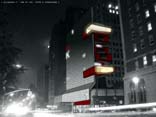 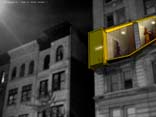 First prize, Gold: Potential Architecture - Fragments and their reconstructions. Frank Shih Her Wang. USA. (>) |
 The author works from the distance of the urban character that in the 19th century Paris Baudelaire and Benjamin called the flâneur - the nameless person from the urban crowd that never participates but always observes in anonymity. The architectural persona in this process is detached from its spatial visioning powers and placed in the shoes of the passerby, the pedestrian, the cab rider, the flâneur, the stocker. The entry arrives to several relaxed but precise proposals that produce an architecture of extraordinary trademark for precisely the casual look that emerges from the corner of the eye of the urban bystander. Probably the most important contribution of this work is the definition of a precise distance. It is a critical distance that creates a reticence to the traditional urge to invent and reinvent architectural compositions. But it is also a precise distance that can mobilize architecture into the municipal scenery that can be glanced-at as we act in the intermediate zones that wraps the urban landscape. SILVER: THE DIGITAL/ANALOG COLLAPSE. The Silver prize went to the work "Ephimeral Mater" from Mirco Becker, Oliver Tessmann, from the firm F-U-R of Germany. Previously, this work won the first prize in the competition "Ephimeral structures in the City of Athens" to be built to host the cultural events as part of the Olympic games of 2004. The entry is a two-dimensional membrane that reshapes itself around four fixed points. |
|||
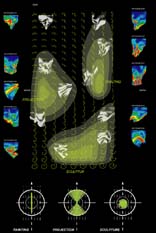 Second Prize, Silver: ephemeralMATTER. Mirco Becker, Oliver Tessmann. F-U-R, Germany. (>) |
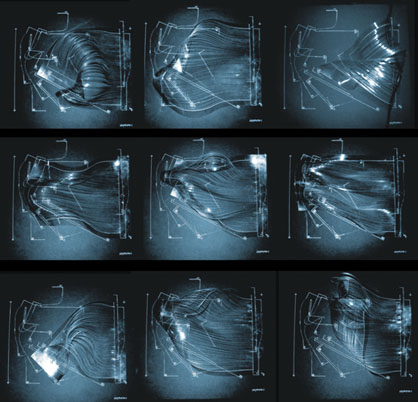 The deformation of the membrane creates a multitude of three-dimensional spatial configurations. The work of F-U-R is a direct and declared inheritant of the nineties engagements in digital architecture. Their particular contribution is the precision placed in the analog/digital investigation processes required for the construction of pieces that intersect both mediums. This particular project searches the compression geometry of the deformation of clamped beams. The authors understand that the investigation cannot only be conducted in the digital models but that also requires performance tests in 1:1 mock up models whose results are feed back into the digital model. The merging of the digital and analog boundary collapses design, testing and construction into one single event and marks a significant departure into the possible futures of one part of architecture. BRONZE: TWO WORKS. Two works shared the third prize. The first one is the design work called "topotransegrity - adaptive spatial organizations" from the firm 5subzero from Austria. |

|
||
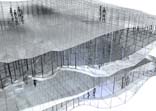  Third Prize (shared), Bronze: Topotransegrity - adaptive spatial organisations. Robert Neumayr, Delphine Ammann, Karim Muallem, Georgina Robledo. 5SUBZERO, Austria. (>) |
 The entry develops the concept of kinetic and adaptable architecture in digital and analog model formats. The authors test the design of Barbican Arts Centre not from the perspective of programmatic organization of space but understand architecture as an act to create inhabitable interface that runs in constant feedback loop with the users by reacting, adapting and anticipating its space to host new activities. |
|||
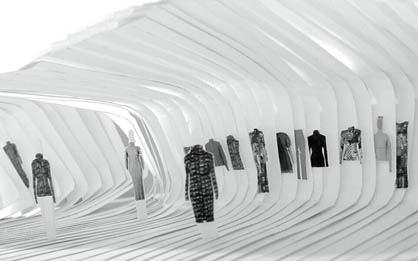 The work "Concept of a new space for Issey Miyake" from Ammar Eloueini of Digit-all Studio, USA, also received third prize. The project is a new retail space and concept for the Issey Miyake stores. The design is based on the fabrication and conception of clothes by Issey Miyake. The space is created by the repetitive introduction of folds that move from ceiling to floor. The proposal asks for the introduction of this system into three stores in France in which each one will be developed with a single material, either opaque or translucent. HONORABLE MENTIONS. Eight more outstanding entries were finalists and received honorable mentions in the competition. The "Cluster:Blaster" entry from RAMTV, UK, present a model for the customization and selling of dwelling units online. Ying-Chang Yu and Wen-Yu Tu, from USA with their work "Analogue Architecture" explore the simulation and potential possibility to design with energy. The entry "Highway...ing" by SMAQ from the Netherlands studies a portion of the high speed roadway near Stuttgart and reprograms it by researching car-related movements and landscape. The work "The face of God" by Benito Raul Juarez Velez from Peru develops a strategic process for documenting and engaging the viewer in the unreliable process of urban stratification. |

 Third Prize (shared), Bronze: Concept of a new space for Issey Miyake. Ammar Eloueini. DIGIT-ALL STUDIO, USA. (>) |
|||
 Honorable mention: The Face of God. Benito Raul Juarez Velez. Peru. (>)  Honorable mention: Highway...ing. Andreas Quednau, Sabine Muller. SMAQ, The Netherlands. (>) 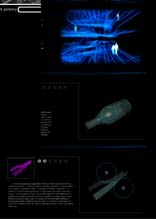 Honorable mention: Analogue Architecture. Ying-Chang Yu, Wen-Yu Tu. Ying-Chang & Wen- Yu Tu, USA. (>) |
 Honorable mention: San Jose University Art Museum. Principal in charge: Hernan Diaz Alonso. Design Team: Timothy Rives Rash II, Tony Trinh, Eric Cheong, Asako Hiraoka, Kevin Sperry, Drura Parrish, Kara Block. Xefirotarch, USA. (>). 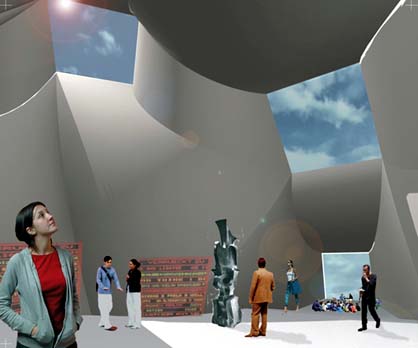 Honorable mention: Immigration Museum in San Diego. Principal: Fernando Romero. Team: Juan Carlos Vidals, Victor Jaime, Mark Seligson, Tatiana Bilbao, Israel Alvarez, Ivonne Santoyo, Manuel Perez, Carlos Bedolla, Deni Ochoa. LCM, MEXICO. (>) The entry "Immigration museum in San Diego" by LCM, Mexico works with the manipulation of data structures encountered in the brief for the design of a Museum to define a compelling construction in which the architecture and the message are consumed at the same time. The "Soft Architecture" entry by Slowmedia, Japan, works with a series of analog/digital performances and design to engage architectural production into the disintegration of both mediums. "City Living Book" from Eichemberg, Cantieri, Miquelini and Saito in Brasil base its project of hybridization of space in the ubiquitous Sao Paulo Subway system. And the entry "San Jose Art Museum" by Xefirotarch form the USA develops the idea of the building as a field to dive into rather than a thing or an object. |
 Honorable mention: cluster:blaster. Robert Sedlak, Aljosa Dekleva, Manuela Gatto, Tina Gregoric, Vasili Stroumpakos. RAMTV, UK. (>)  Honorable mention: City:Living Book - Architecture in Process. Andre Teruya Eichemberg, Alessandra Ennes Cantieri, Daniel Mottosinho Alvite, Julio Miquelini, Rubens Tadamiti Saito. Brazil. (>) 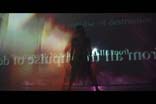 Honorable mention: Soft Architecture. Jin Hidaka, Hiroyuki Kamei, Kazuhiro Takijiri. Slowmedia, Japan. (>) |
||
| THE
CRISIS OF THE OBJECT. The 117 entries presented 117 possible future
visions for architecture. If there is an overall theme in the competition
it is related to the recurrent visit the plastic arts continues to make
to Andre Breton call for a "fundamental crisis of the object." But this
time the response is not "frottage" - as Breton called the strategy
of disruption via irritation that was mastered in the arts from Duchamp's
"readymades" to André Cadere "Barres de Bois." The response is engagement.
Engagement in ventures and systems that at this point in architectural
history have a life of their own and that have became quite personal.
Which like an expanding universe generates its own galactic systems
and black holes. If there is an overall critique and questioning, as
every competition should have, is how that engagement relates, develop
distance, or implements its generative processes into the possible futures
of urbanity and life. The response again will be quite personal. Alfredo Andia bienalmiami@alexandria.cc |
||||
|
first
phase jury: |
||||